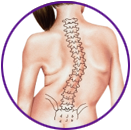Adult Kyphosis-Types and Causes

Adult kyphosis, the condition of curve in spine is categorized into the following major types:
- Postural Kyphosis
- Scheuermann’s Kyphosis
- Congenital Kyphosis
- Paralytic Disorders
- Post-Traumatic Kyphosis
- Post-Surgical Kyphosis
- Degenerative Kyphosis
Postural Kyphosis
Postural kyphosis is the result of poor posture and is common in adolescents and younger adults. Slouching posture when sitting or standing tends to cause the spine to curve forward.
It is often associated with hyperlordosis of the lumbar portion of the spine. The lumbar spine normally has an inward curve. Hyperlordosis means the lumbar spine curves too far in the opposite direction.
Postural kyphosis can be rectified by adopting correct posture while sitting and standing along with strengthening exercises for back muscles.
Scheuermann’s Kyphosis
Scheuermann’s kyphosis is a condition in which the thoracic curve is between 45 and 75 degrees. Vertebral wedging of more than 5 degrees can be seen in three or more adjacent vertebrae. In these cases, the vertebrae appear triangular shaped .At the ends of the wedged vertebrae, Schmorl’s nodes (small herniations of the intervertebral disc) are formed. Exact cause for Scheuermann’s Kyphosis remains unknown and the probable causes may be avascular necrosis of the cartilage ring of vertebral body, vertebral disorders, or mild osteoporosis.
Congenital Kyphosis
Congenital kyphosis is an inherited condition of spine caused because of abnormal development of spine in womb. There may be incomplete formation of the spine present at birth, which later can lead to a severe abnormal kyphosis. It may also cause paralysis of the lower part of the body. Congenital abnormalities in the urinary collecting system may also be associated with this type of kyphosis.
Surgery is considered successful in treating severe congenital kyphosis. Generally, early surgical intervention is said to provide good results and halt the progression of the curve further. However, non-surgical means are less suitable for this type of kyphosis.
Paralytic Disorders
Kyphosis may gradually develop in certain paralytic disorders such as poliomyelitis, spinal muscle atrophy, and cerebral palsy.
Post-Traumatic Kyphosis
Spinal injuries can lead to kyphosis and nerve problems in the spine. Most of the times, when there is vertebral fracture in the thoracic or lumbar spine some degree of kyphosis may result.
Post-traumatic kyphosis can be treated with bracing or surgery depending on the severity of the condition.
Post-Surgical Kyphosis
Post-surgical Kyphosis is the development of kyphosis following the spine surgery to correct other defects. This occurs when the healing is improper after surgery. A spinal fusion may not heal completely leading to unstable fusion which may cause the spine to collapse. The ligaments of the spine may not heal in an adequate manner to support the vertebrae and a kyphosis may develop. These problems need to be corrected with a second operation.
Degenerative Kyphosis
Degenerative kyphosis may be caused by wear and tear of the lumbar portion of the spine. The degenerative process results in collapse of the intervertebral disc, changes in the shape of the vertebrae, and weakening of the ligaments that support the spine. This can cause kyphosis over a long period of time.
Other Causes
Systemic diseases also can cause kyphosis over time. These conditions include infection in the spine, cancer or tumors of the spine, and certain types of systemic arthritis. Kyphosis can also develop in people who have had radiation treatment for malignant cancers in their childhood.
Other Conditions List
- Spine Deformities
- Degenerative Disc Disease
- Herniated Disc (Lumbar)
- Herniated Disc (Cervical)
- Cervical Stenosis
- Lumbar Stenosis
- Cervical Disc Protrusion
- Sciatica
- Scoliosis
- Spine Tumors
- Spondylolisthesis
- Ankylosing Spondylitis
- Adult Kyphosis
- Scheuermann’s Kyphosis
- Back Pain
- Neck Pain
- Mid-back Pain
- Sacroiliac Joint Dysfunction
- Spine Trauma
- Spinal Injuries at work
- Spinal Fractures
- Spondyloarthropathies
- Spondylolysis
- Facet Joint Arthritis
- Piriformis Syndrome
- Whiplash
- DISH (Diffuse Idiopathic Skeletal Hyperostosis)
- Burners and Stingers
- Myelopathy
- Degenerative Spine
- Cervical Degenerative Disorders
- Vertebral Fractures




 Menu
Menu